NTDB & NTMS Specifications (250K & 100K)
|
Updated: 11 December 2006
2.3 Hydrography
2.3.1 Water Tanks
2.3.1.1 Example 1
| |
| Location of Example: |
152o20'25" East, 25o51'04" South |
| Distinctive Characteristics: |
- Water Towers appear as circular elevated features. This is evident by the shadow signature.
- Water Tanks/Water Towers are typically found in residential/urban areas, unlike Storage Tanks which are typically found in industrial/commercial areas.
- Water Tanks/Water Towers tend to be solitary, unlike Storage Tanks that are typically concentrated in one area.
|
| Regional Considerations: |
|
| Figure: 2.3.1.1 Representation of Water Tanks |
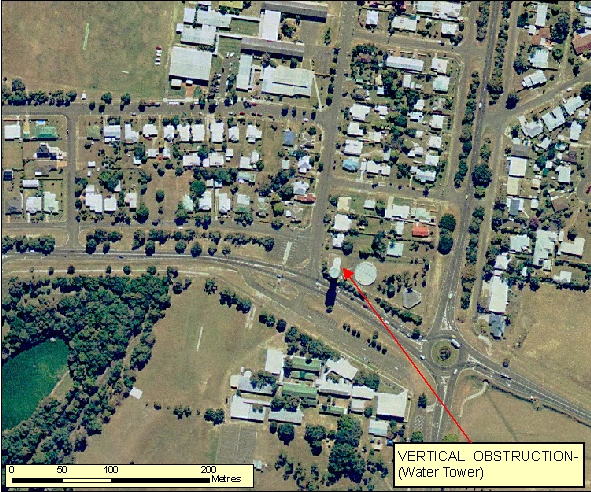
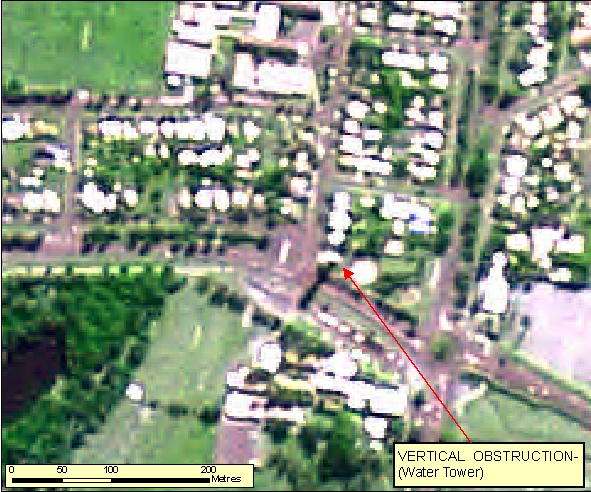
[back to top]
2.3.1.2 Example 2
| |
| Location of Example: |
| Distinctive Characteristics: |
- Water Towers are of various constructions as per Figure: 2.3.1.2.
- Water Towers are typically located within or nearby Population Centres, they are significant topographic features because of their height.
|
| Regional Considerations: |
|
| Figure: 2.3.1.2 Photographs of Water Towers. |
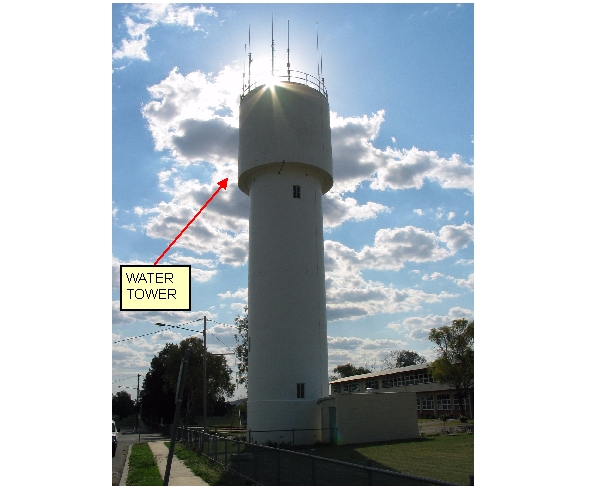
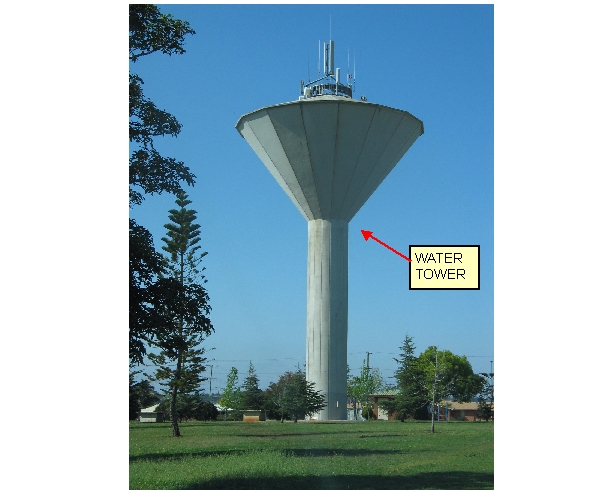
[back to top]
2.3.2 Canals
2.3.2.1 Example 1
| |
| Location of Example: |
152o19'30" East, 24o56'35" South |
| Distinctive Characteristics: |
- Drains/Canals can be differentiated from Roads as they do not provide connectivity to the existing road network.
- If the Drain/Canal is completely dry it will appear lighter, similar to the surrounding soil and vegetation. The the edges will often appear much lighter, due to the excavated soil from construction.
- Drains generally start at a water source and can end at a Reservoir, Water Tank or Sea.
- Drains follow the topography of the land whereas roads may traverse hills and valleys.
- In Figure 2.3.2.1a the canals appear as dark blue linear bodies when filled with water.
- The use of mulitspectral imagery band combinations can aid in the interpretation and differentiation of water.
|
| Regional Considerations: |
- In areas where there is irrigated crop farming Canals/Drains appear as regular structured networks which show a water flow hierarchy diminishing from source. They are often aligned with paddocks and have access tracks or roads running parallel to them.
|
| Figure: 2.3.2.1 Representation of Canals |
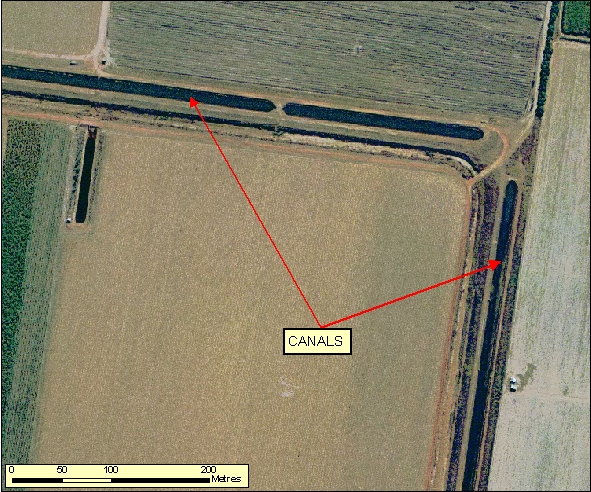
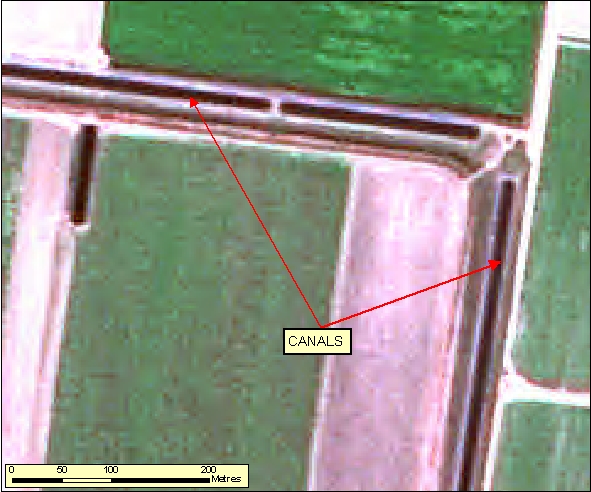
[back to top]
2.3.2.2 Example 2
| |
| Location of Example: |
152o52'19" East, 25o22'57" South |
| Distinctive Characteristics: |
- Drains/Canals can be differentiated from Roads as they do not provide connectivity to the existing road network.
- In Figure: 2.3.2.2b note that the upper part of the drain near the water source gives off a light blue signature, indicating presence of water. The drain terminates at the water tank which also shows the same water signature.
- If the Drain/Canal is completely dry it will appear lighter, similar to the surrounding soil and vegetation. The the edges will often appear much lighter, due to the excavated soil from construction.
- Drains generally start at a water source and can end at a Reservoir, Water Tank or Sea.
- Drains follow the topography of the land whereas roads may traverse hills and valleys.
- The use of mulitspectral imagery band combinations can aid in the interpretation and differentiation of water.
|
| Regional Considerations: |
|
| Figure: 2.3.2.2 Representation of Canals |
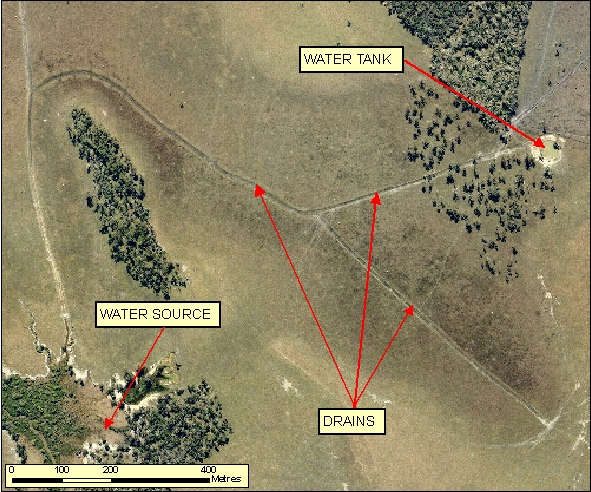
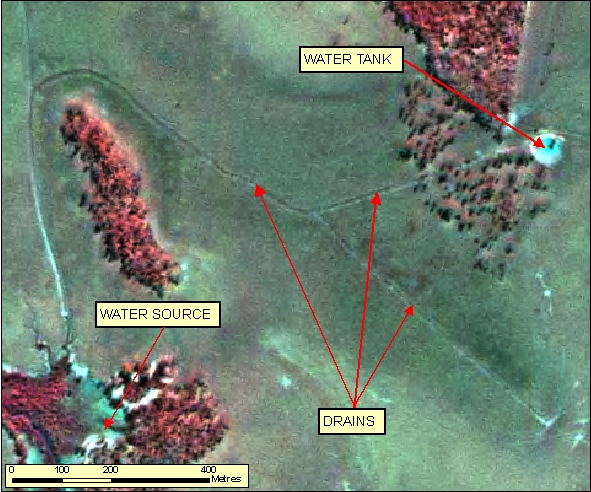
[back to top]
2.3.2.3 Example 3
| |
| Location of Example: |
149o33'42" East, 28o37'13" South |
| Distinctive Characteristics: |
- Drains/Canals can be differentiated from Roads as they do not provide connectivity to the existing road network.
- If the Drain/Canal is completely dry it will appear lighter, similar to the surrounding soil and vegetation. The the edges will often appear much lighter, due to the excavated soil from construction.
- Drains generally start at a water source and can end at a Reservoir, Water Tank or Sea.
- Drains follow the topography of the land whereas roads may traverse hills and valleys.
- The use of mulitspectral imagery band combinations can aid in the interpretation and differentiation of water.
|
| Regional Considerations: |
- In areas where there is irrigated crop farming Canals/Drains appear as regular structured networks which show a water flow hierarchy diminishing from source. They are often aligned with paddocks and have access tracks or roads running parallel to them.
|
| Figure: 2.3.2.3 Representation of Canals in association with surrounding features. |
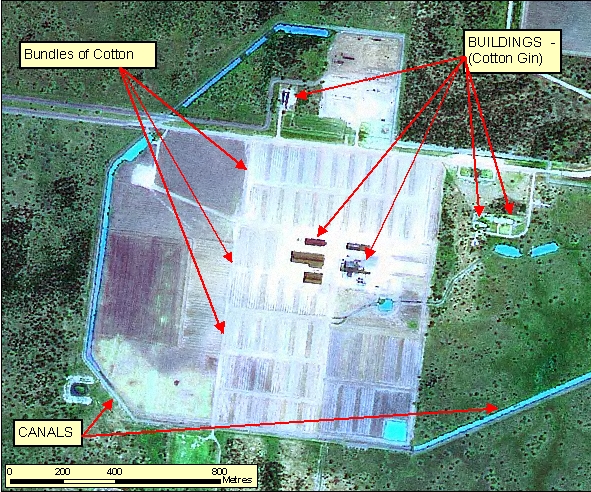
[back to top]
2.3.2.4 Example 4
| |
| Location of Example: |
|
| Distinctive Characteristics: |
- This is an example of a large Canal partially filled with water used for the purpose of Flood Irrigation in regional New South Wales. Note the width, depth and length of this Canal.
|
| Regional Considerations: |
|
| Figure: 2.3.2.4 Photograph of a Canal |
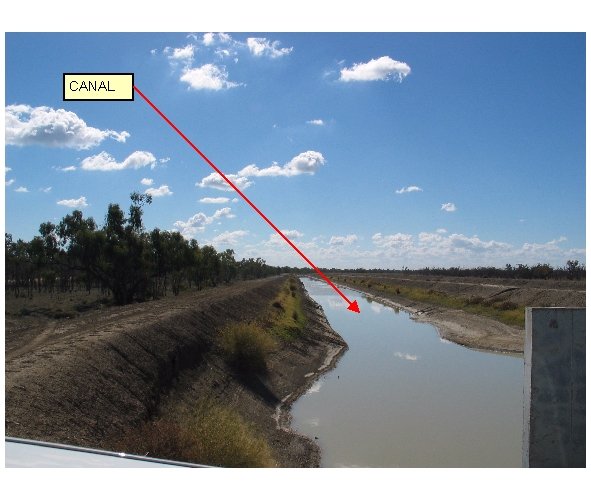
[back to top]
2.3.3 Pondage Areas
2.3.3.1 Example 1
| |
| Location of Example: |
151o06'32" East, 24o47'52" South |
| Distinctive Characteristics: |
- Aquaculture Areas are typically more frequent and smaller in size compared to Settling Ponds.
- Aquaculture Areas can be differentiated from Settling Ponds due to their proximity to other features such as town rural water supply, whereas Settling Ponds are rarely found near Town Rural Storage Reservoirs.
- Aquaculture Areas are easily identified on imagery due to their rectangular or geometric shapes.
|
| Regional Considerations: |
|
| Figure: 2.3.3.1 Representation of Aquaculture Areas. |
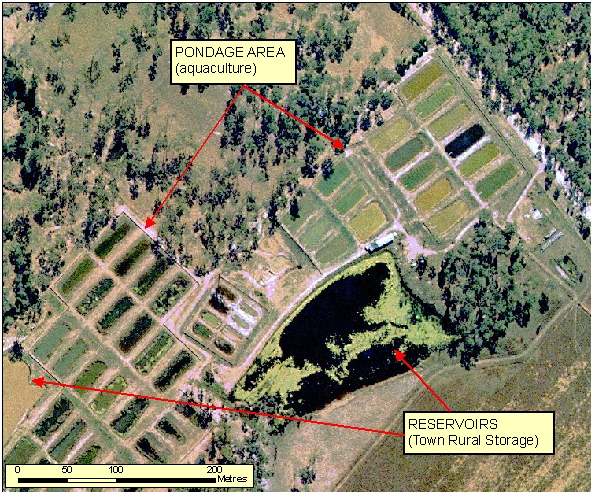
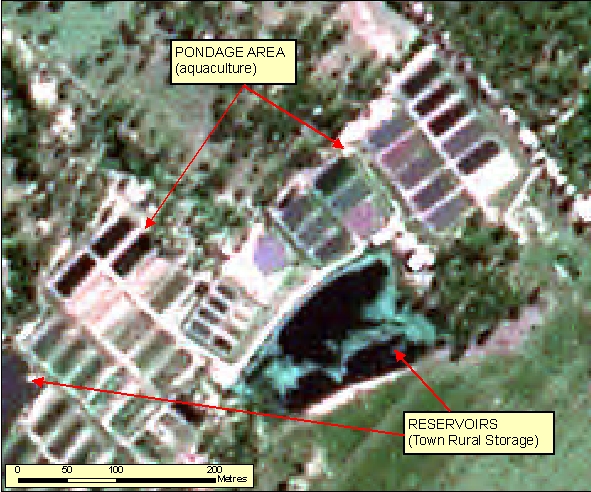
[back to top]
2.3.3.2 Example 2
| |
| Location of Example: |
152o06'13" East, 24o37'02" South |
| Distinctive Characteristics: |
- Aquaculture Areas are typically more frequent and smaller in size compared to Settling Ponds.
- Aquaculture Areas can be differentiated from Settling Ponds due to their proximity to other features such as town rural water supply, whereas Settling Ponds are rarely found near Town Rural Storage Reservoirs.
- Aquaculture Areas are easily identified on imagery due to their rectangular or geometric shapes.
|
| Regional Considerations: |
|
| Figure: 2.3.3.2 Representation of Aquaculture Areas. |
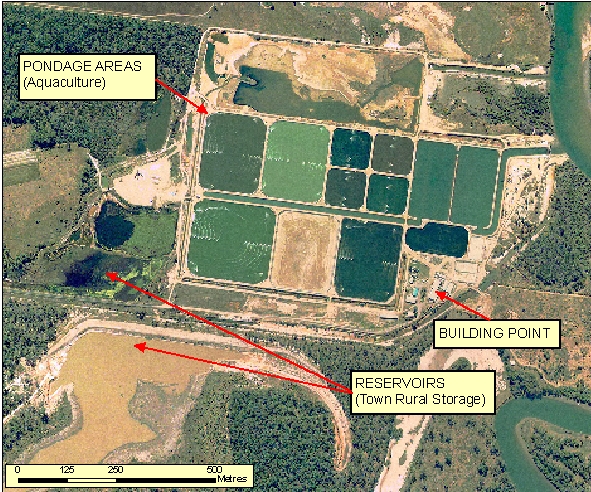
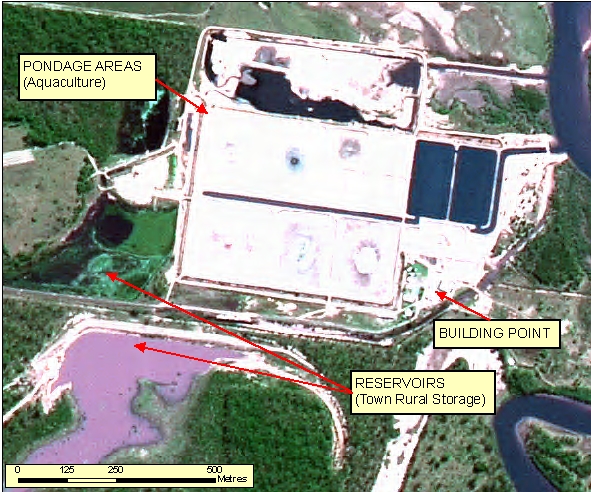
[back to top]
2.3.3.3 Example 3
| |
| Location of Example: |
152o48'59" East, 25o16'23" South |
| Distinctive Characteristics: |
- Settling Ponds appear on imagery as large geometric shaped ponds separated by levees.
- Sewage Settling Ponds may be distinguished from other types of ponds by the presence of the treatment tanks and plant infrastructure.
- Settling Ponds are isolated from the natural hydrological network.
|
| Regional Considerations: |
|
| Figure: 2.3.3.3 Representation of Settling Ponds. |
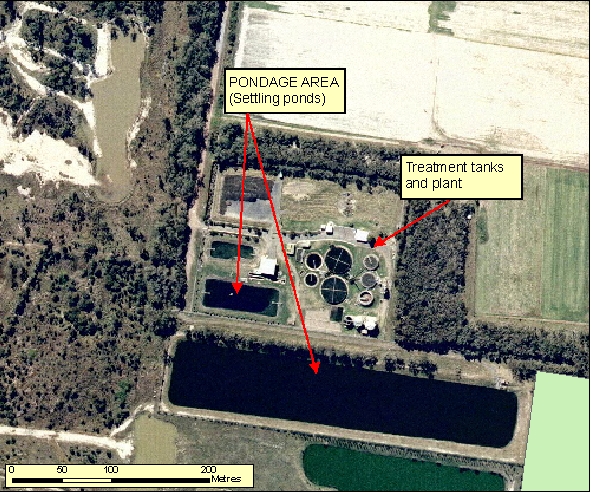
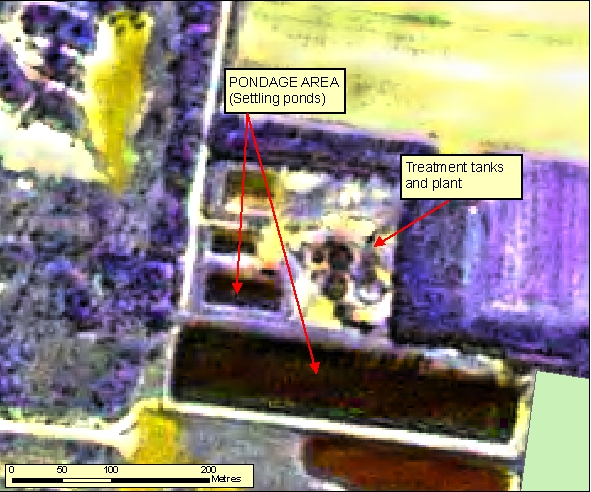
[back to top]
2.3.3.4 Example 4
| |
| Location of Example: |
152o37'08" East, 25o12'40" South |
| Distinctive Characteristics: |
- Settling Ponds appear on imagery as large geometric shaped ponds separated by levees.
- Sewage Settling Ponds may be distinguished from other types of ponds by the presence of the treatment tanks and plant infrastructure.
- Settling Ponds are isolated from the natural hydrological network.
|
| Regional Considerations: |
|
| Figure: 2.3.3.4 Representation of Settling Ponds. |
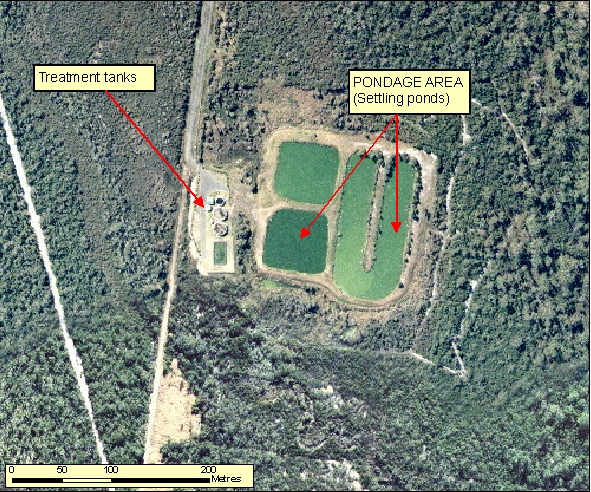
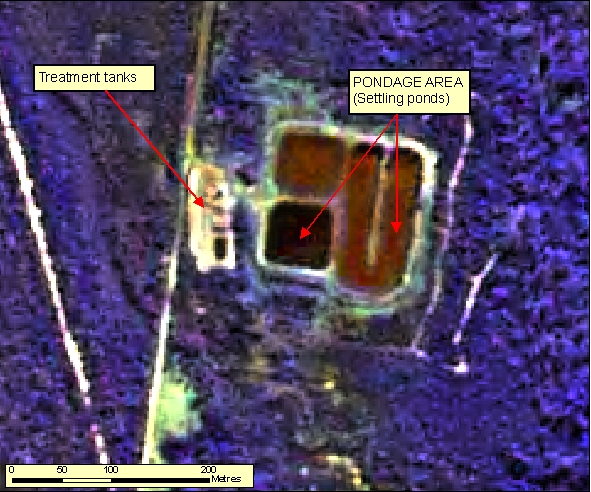
[back to top]
2.3.5 Reservoirs
2.3.5.1 Example 1
| |
| Location of Example: |
152o39'54" East, 25o21'41" South, |
| Distinctive Characteristics: |
- Note the Dam Wall which creates the Reservoir.
- Dam Walls are absent from naturally occurring Lakes.
- Dam Walls can be constructed from both concrete, stone and earthen materials. Each will display a different signature on multispectral imagery.
- Dam Walls may cover the partial boundary of the Reservoir or its entirity depending on the topography and method of construction of the Reservoir.
|
| Regional Considerations: |
|
| Figure: 2.3.5.1 Representation of a Reservoir in association with surrounding features. |
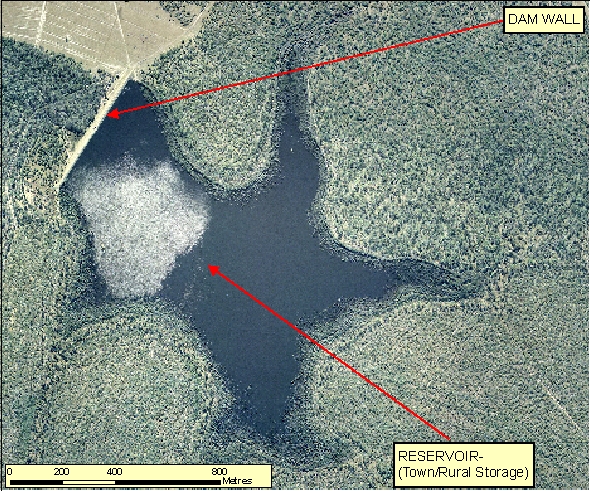
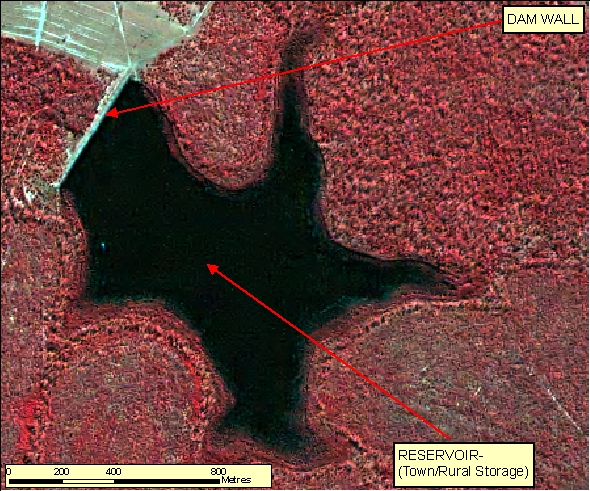
[back to top]
2.3.5.2 Example 2
| |
| Location of Example: |
151o06'32" East, 24o47'52" South, |
| Distinctive Characteristics: |
- Town Rural Storage in this example is being used to provide water to the aquacultural facility and not for human consumption.
- Dam Walls are absent from naturally occurring Lakes.
- Dam Walls can be constructed from both concrete, stone and earthen materials. Each will display a different signature on multispectral imagery.
- Dam Walls may cover the partial boundary of the Reservoir or its entirity depending on the topography and method of construction of the Reservoir.
|
| Regional Considerations: |
|
| Figure: 2.3.5.2 Representation of a Reservoir in association with surrounding areas. |


[back to top]
2.3.5.3 Example 3
| |
| Location of Example: |
149o35'21" East, 28o35'52" South, |
| Distinctive Characteristics: |
- Large Flood Irrigation Reservoirs can be identified by related infrastructure, such as Cotton Gin facilities that require Flood Irrigation practices.
- Dam Walls are absent from naturally occurring Lakes.
- Dam Walls can be constructed from both concrete, stone and earthen materials. Each will display a different signature on multispectral imagery.
- Dam Walls may cover the partial boundary of the Reservoir or its entirity depending on the topography and method of construction of the Reservoir.
|
| Regional Considerations: |
|
| Figure: 2.3.5.3 Representation of a Reservoir in association with surrounding features. |
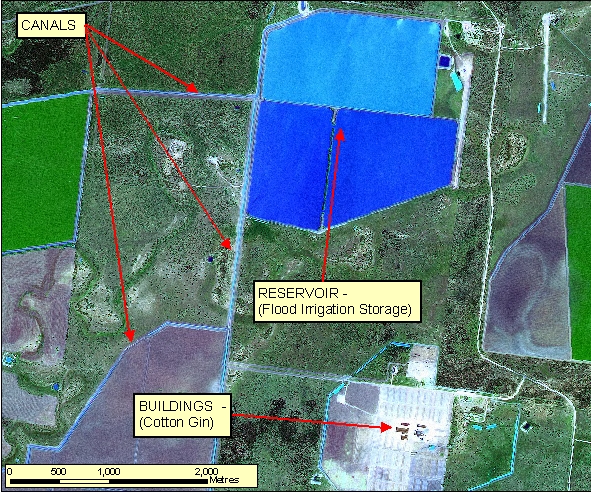
|
